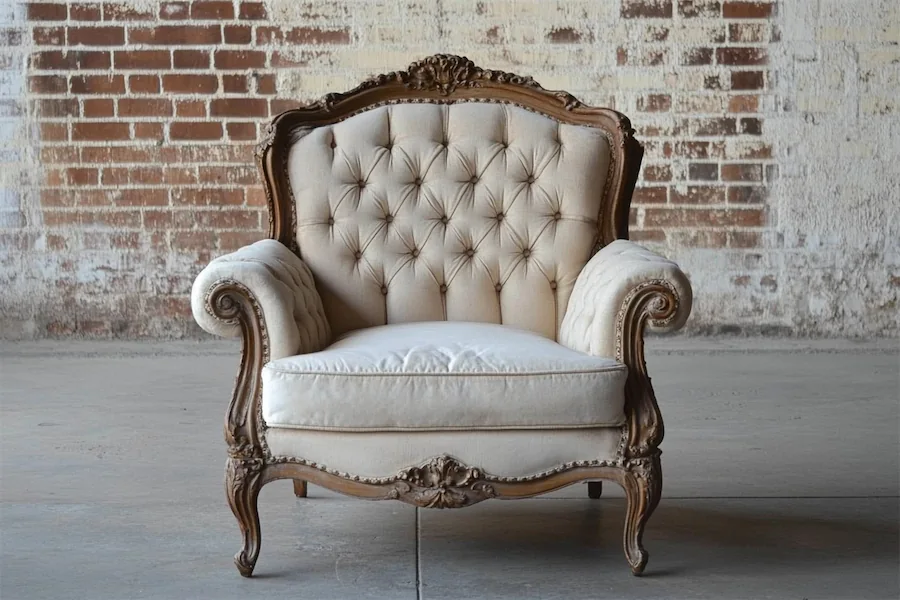French antique chairs are celebrated for their exquisite craftsmanship, intricate designs, and the rich history they embody. Spanning several centuries, these chairs reflect the artistic and cultural evolution of France, with each period introducing distinct styles and characteristics.
Introduction to French Antique Chairs
French antique chairs encompass a variety of designs that emerged from different historical periods, each influenced by the prevailing artistic trends, political climates, and societal preferences of the time. From the opulence of the Baroque era to the refined elegance of Neoclassicism, these chairs not only served functional purposes but also stood as symbols of status and taste.
History and Origins of French Antique Chairs
The evolution of French antique chairs can be traced through several key periods:
- Louis XIII (1590–1660): Chairs from this era were robust and rectangular, often featuring low relief carvings and geometric patterns. The use of dark woods like walnut was prevalent, and upholstery, when present, was typically in rich fabrics such as velvet or tapestry.
- Louis XIV (1660–1715): Under the reign of Louis XIV, furniture became more ornate, reflecting the grandeur of the Sun King’s court. Chairs featured high backs, elaborate carvings, and gilded finishes. The introduction of the fauteuil (an open-arm chair with a primarily exposed wooden frame) became popular during this time.
- Régence (1715–1730): This transitional period saw a shift towards more curved forms and lighter designs. Chairs became more comfortable, with padded seats and backs, and cabriole legs (legs that curve outward at the knee and inward at the ankle) became a defining feature.
- Louis XV (1730–1770): The Rococo style dominated this era, characterized by asymmetry, intricate carvings of floral and shell motifs, and the use of lighter woods. The bergère (a closed-arm, upholstered armchair) became fashionable, offering both comfort and elegance.
- Louis XVI (1770–1789): A return to classical influences marked this period, with chairs featuring straight lines, fluted legs, and motifs such as laurel wreaths and ribbons. The medallion-back chair, with its oval-shaped backrest, became a hallmark of this style.
Key Features of French Antique Chairs
French antique chairs are distinguished by several key features:
- Craftsmanship: Meticulous attention to detail, with hand-carved decorations and high-quality joinery.
- Materials: Use of premium woods such as walnut, oak, and mahogany, often complemented by luxurious fabrics like silk, velvet, and brocade.
- Design Elements: Incorporation of stylistic motifs corresponding to their respective periods, including floral patterns, geometric shapes, and classical symbols.
- Comfort: Evolution from rigid forms to more ergonomic designs, with increased padding and upholstery for enhanced comfort.
Applications of French Antique Chairs
French antique chairs serve both functional and aesthetic purposes in various settings:
- Interior Décor: As statement pieces, they add a touch of elegance and history to living rooms, dining areas, and bedrooms.
- Collecting: Sought after by collectors for their historical significance and artistry, often appreciating in value over time.
- Restoration Projects: Restored antique chairs can preserve traditional craftsmanship and are often used in heritage properties and museums.
Considerations When Choosing French Antique Chairs
When selecting a French antique chair, consider the following factors:
- Authenticity: Verify the chair’s provenance and ensure it is a genuine piece from the claimed period.
- Condition: Assess the structural integrity and look for signs of damage or previous repairs that may affect its value or usability.
- Style Compatibility: Ensure the chair’s design aligns with your existing décor and personal aesthetic preferences.
- Investment Value: Research market trends to understand the potential appreciation of the piece over time.
Conclusion
French antique chairs encapsulate the rich tapestry of France’s artistic and cultural heritage. Each style tells a story of its era, reflecting the tastes, technologies, and societal norms of the time. Incorporating such a piece into your space not only adds aesthetic value but also connects you to a lineage of exquisite craftsmanship and historical significance.
